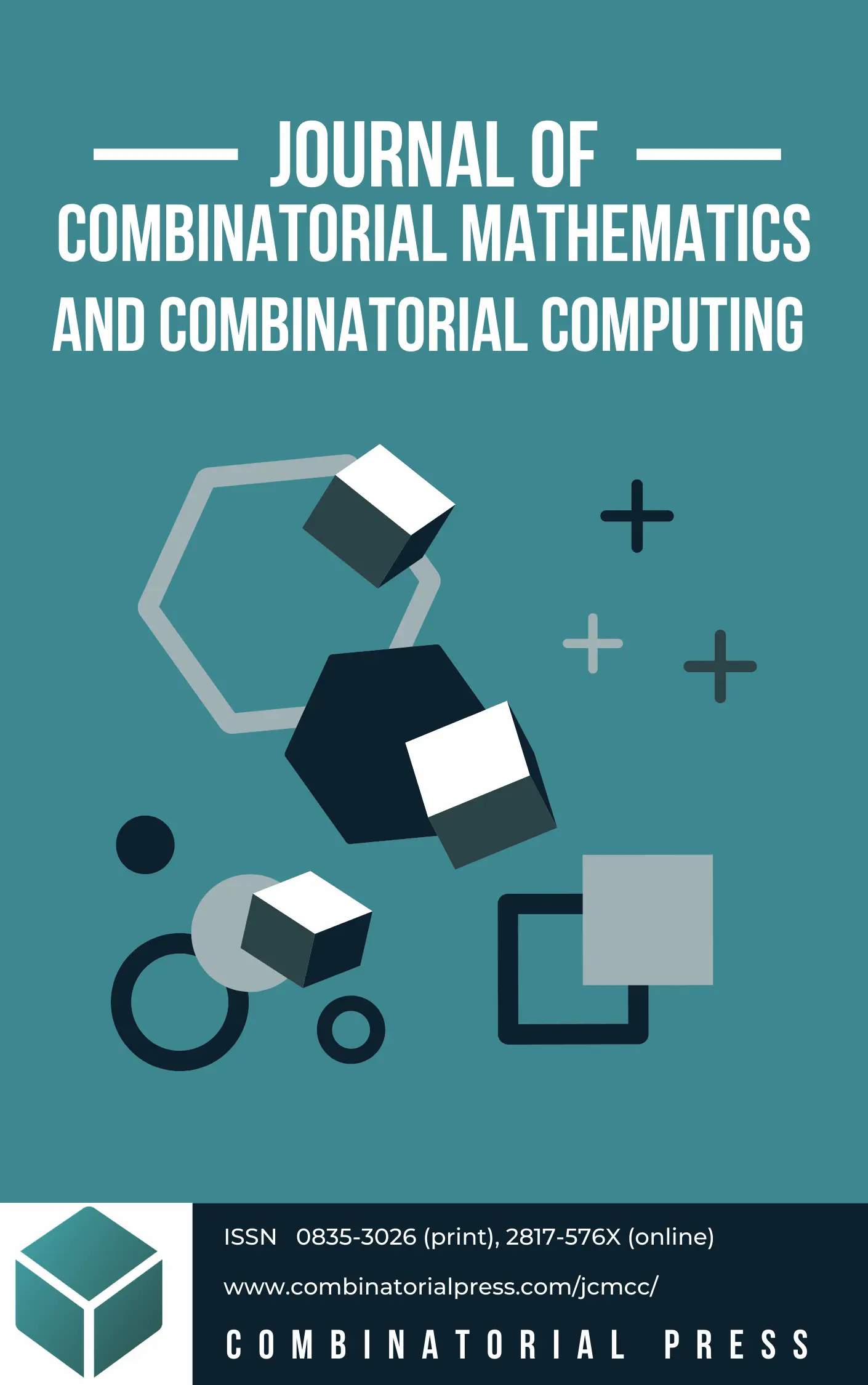
Journal of Combinatorial Mathematics and Combinatorial Computing
ISSN: 0835-3026 (print) 2817-576X (online)
The Journal of Combinatorial Mathematics and Combinatorial Computing (JCMCC) embarked on its publishing journey in April 1987. From 2024 onward, it publishes four volumes per year in March, June, September and December. JCMCC has gained recognition and visibility in the academic community and is indexed in renowned databases such as MathSciNet, Zentralblatt, Engineering Village and Scopus. The scope of the journal includes; Combinatorial Mathematics, Combinatorial Computing, Artificial Intelligence and applications of Artificial Intelligence in various files.
Information Menu
- Research article
- https://www.doi.org/10.61091/jcmcc119-32
- Full Text
- H. Aouf\(^{1,*}\), H. Al-Ezeh\(^{1}\) and M. Ghanem\(^{1}\)
- Journal of Combinatorial Mathematics and Combinatorial Computing
- Volume 119
- Pages: 335-345
- Published: 31/03/2024
Let \(c\) be a proper \(k\)-coloring of a connected graph \(G\) and \(\pi=\{S_{1},S_{2},\ldots,S_{k}\}\) be an ordered partition of the vertex set \(V(G)\) into the resulting color classes, where \(S_{i}\) is the set of all vertices that receive the color \(i\). For a vertex \(v\) of \(G\), the color code \(c_{\pi}(v)\) of \(v\) with respect to \(\pi\) is the ordered \(k\)-tuple \(c_{\pi}(v)=(d(v,S_{1}),d(v,S_{2}),\ldots,d(v,S_{k}))\), where \(d(v,S_{i})=min\{d(v,u):\textit{ } u\in S_{i}\}\) for \(1\leqslant i \leqslant k\). If all distinct vertices of \(G\) have different color codes, then \(c\) is called a locating coloring of \(G\). The locating chromatic number is the minimum number of colors needed in a locating coloring. In this paper, we determine the locating-chromatic number for the middle graphs of Path, Cycle, Wheel, Star, Gear and Helm graphs.
- Research article
- https://www.doi.org/10.61091/jcmcc119-31
- Full Text
- Kieran Clancy\(^{1}\), Michael Haythorpe\(^{1,*}\) and Alex Newcombe\(^{1}\)
- Journal of Combinatorial Mathematics and Combinatorial Computing
- Volume 119
- Pages: 323-333
- Published: 31/03/2024
There has been significant research dedicated towards computing the crossing numbers of families of graphs resulting from the Cartesian products of small graphs with arbitrarily large paths, cycles and stars. For graphs with four or fewer vertices, these have all been computed, but there are still various gaps for graphs with five or more vertices. We contribute to this field by determining the crossing numbers for fifteen such families.
- Research article
- https://www.doi.org/10.61091/jcmcc119-30
- Full Text
- Atif Abueida\(^{1,*}\) and Kenneth Roblee\(^{2}\)
- Journal of Combinatorial Mathematics and Combinatorial Computing
- Volume 119
- Pages: 313-321
- Published: 31/03/2024
A graph \(G\) with vertex set \(V = V(G)\) and edge set \(E = E(G)\) is harmonious if there exists a harmonious labeling of \(G\); which is an injective function \(f:V(G) \rightarrow \mathbf{Z}_m\) provided that whenever \(e_1, e_2 \in E\) are distinct with endpoints \(u_1,v_1\) and \(u_2,v_2\), respectively, then \(f(u_1) + f(v_1) \not\equiv f(u_2) + f(v_2) (\hbox{mod } m )\). Using basic group theory, we prove in a different manner an already established result that a disjoint union of an odd cycle and a path is harmonious provided their lengths satisfy certain conditions. We apply the same basic idea to establish that, under the same conditions, a disjoint union of an odd cycle with a certain starlike tree is harmonious (where a starlike tree consists of a central vertex that is adjacent to an endpoint of a certain number of fixed length paths). Finally, we extend the latter result to include specifying that the central vertex in the tree be adjacent to different vertices in each of the \(t\)-many \(s\)-paths.
- Research article
- https://www.doi.org/10.61091/jcmcc119-29
- Full Text
- Zhihua Liang\(^{1,*}\)
- Journal of Combinatorial Mathematics and Combinatorial Computing
- Volume 119
- Pages: 305-312
- Published: 31/03/2024
Under the background of my country’s new rural construction and the implementation of the rural revitalization strategy, the rural economy has ushered in an unprecedented opportunity for development. Agricultural economic management plays a catalytic role in providing direction guidance for rural economic development, promoting sustainable rural economic development, and providing a good environment for rural economic development. However, there are some drawbacks in agricultural economic management, which are mainly reflected in the imperfect agricultural economic management system and the lag in information infrastructure construction. In view of this, the author puts forward corresponding the advanced VAR model from the aspects of improving the agricultural economic management system, improving the application level of information technology, and improving the quality of the agricultural economic management team. Research shows that: through effective management of agricultural economy, the obstacles to agricultural economic development can be reduced from the source, thereby promoting the healthy and sustainable development of rural economy.
- Research article
- https://www.doi.org/10.61091/jcmcc119-28
- Full Text
- Qingyu Ci\(^{1,*}\)
- Journal of Combinatorial Mathematics and Combinatorial Computing
- Volume 119
- Pages: 291-303
- Published: 31/03/2024
This paper mainly focuses on the algorithms related to local path planning and path tracking control of unmanned vehicles in the process of obstacle avoidance. By introducing the temporal dimension as a reference, the perceptual results are projected onto the 3D spatio-temporal navigation map by combining the multi-target behavior prediction and other means; by increasing the temporal dimension, the static obstacles and dynamic obstacles are unified into the same parameter space. Under this parameter space, the front-end A* path search initializes the unified B spline curve control points, designs the trajectory cost function and performs nonlinear optimization to generate a spatio-temporal trajectory that satisfies the safety collision-free and vehicle motion constraints (speed and acceleration limits), thus transforming the decision and planning problem under the two-dimensional fence dynamic physical space into a static scene decision and planning problem under the three-dimensional spatio-temporal space. Through simulation verification, the whole process of the proposed trajectory planning method takes 51.27ms on average, which meets the driving requirements of driverless cars. In addition, by adjusting the search conditions of the A* algorithm, its overall planning efficiency is improved by 27.86% compared with the search speed of the traditional algorithm. The actual feeling and data results from the real vehicle experiments show its good tracking effect, which verifies the effectiveness and practicality of the algorithm proposed in this paper.
- Research article
- https://www.doi.org/10.61091/jcmcc119-27
- Full Text
- Yue Teng\(^{1}\) and Xianzhi Kang\(^{1,*}\)
- Journal of Combinatorial Mathematics and Combinatorial Computing
- Volume 119
- Pages: 277-289
- Published: 31/03/2024
Based on the visual servo technology, this paper focuses on the visual tracking algorithm of moving objects and the dynamic grasping control method of robots, and realizes the automatic loading and unloading of moving workpieces to improve production efficiency. Firstly, aiming at the difficulties in the selection of high-dimensional features extracted by visual servo, this paper proposes a training method of generation countermeasure network based on heuristic algorithm by using the efficient search ability of heuristic algorithm. Secondly, we use image processing technology to realize real-time recognition and location of workpieces under complex background. According to the positioning results, an adaptive dual rate unscented Kalman filter visual tracking algorithm is proposed to solve the problem of delay and multi sampling rate in visual servo, and realize visual tracking of moving objects. The experimental results show that the proposed visual tracking algorithm has better stability and real-time performance.
- Research article
- https://www.doi.org/10.61091/jcmcc119-26
- Full Text
- Alvaro Carbonero\(^{1,*}\) and Dylan Obata\(^{1}\)
- Journal of Combinatorial Mathematics and Combinatorial Computing
- Volume 119
- Pages: 265-276
- Published: 31/03/2024
For any positive integer \(h\), a graph \(G=(V,E)\) is said to be \(h\)-magic if there exists a labeling \(l:E(G)\to \mathbb{Z}_h -\{0\}\) such that the induced vertex set labeling \(\ l^+ : V(G) \to \mathbb{Z}_h \) defined by
\[
l^+ (v)=\sum_{uv \in E(G)} \ l(uv)
\]
is a constant map. The integer-magic spectrum of a graph \(G\), denoted by \(IM(G)\), is the set of all \(h \in \mathbb{N}\) for which \(G\) is \(h\)-magic. So far, only the integer-magic spectra of trees of diameter at most five have been determined. In this paper, we determine the integer-magic spectra of trees of diameter six and higher.
- Research article
- https://www.doi.org/10.61091/jcmcc119-25
- Full Text
- M. Kheibari\(^{1}\), H. Abdollahzadeh Ahangar\(^{2,*}\), R. Khoeilar\(^{1}\) and S.M. Sheikholeslami\(^{1}\)
- Journal of Combinatorial Mathematics and Combinatorial Computing
- Volume 119
- Pages: 255-263
- Published: 31/03/2024
A total Roman \(\{2\}\)-dominating function on a graph \(G = (V,E)\) is a function \(f:V\rightarrow\{0,1,2\}\) with the properties that (i) for every vertex \({v}\in V\) with \(f({v})=0\), \(f(N({v}))\ge2\) and (ii) the set of vertices with \(f({v})>0\) induces a subgraph with no isolated vertices. The weight of a total Roman \(\{2\}\)-dominating function is the value \(f(V)=\sum_{{v}\in V}f({v})\), and the minimum weight of a total Roman \(\{2\}\)-dominating function is called the total Roman \(\{2\}\)-domination number and denoted by \(\gamma_{tR2}(G)\). In this paper, we prove that for every graph \(G\) of order \(n\) with minimum degree at least two, \(\gamma_{tR2}({G})\leq \frac{5n}{6}\).
- Research article
- https://www.doi.org/10.61091/jcmcc119-24
- Full Text
- Yi Qu\(^{1,*}\)
- Journal of Combinatorial Mathematics and Combinatorial Computing
- Volume 119
- Pages: 245-254
- Published: 31/03/2024
The penetration of virtual classroom teaching into German teaching is the presentation of teaching innovation in the information age. In this work, we explore the necessity of applying virtual classroom teaching in German classrooms and the effective strategies of German teaching innovation in virtual classrooms, to provide some suggestions for the reform of German teaching. First, the GPS trajectories are transformed into a sequence of hotspot regions using the spatiotemporal properties of GPS points. Then, a sequential pattern mining algorithm of asynchronous cycles with multiple minimum supports based on pattern growth is adopted, and the sequential patterns of asynchronous cycles are deeply recursively mined according to the multiple minimum supports. Experiments show that the proposed IoT-assisted teaching scheme can effectively integrate equipment resources, mine spatiotemporal information, and help students and teachers establish a new educational method of integrating space and land. Compared with the baseline, it can fully exploit the characteristics of German.
- Research article
- https://www.doi.org/10.61091/jcmcc119-23
- Full Text
- Hongfei Zhang\(^{1,2,*}\)
- Journal of Combinatorial Mathematics and Combinatorial Computing
- Volume 119
- Pages: 233-244
- Published: 31/03/2024
The limitations of existing procedures make it difficult to locate and identify old subterranean culverts in urban infrastructure management. In order to effectively manage urban infrastructure, subterranean pipe culverts must be accurately located and detected. In this research, we investigate the method of computing the shortest distance from the point to the ellipse and propose a pipeline collision detection method based on the projection of the direction of the common perpendicular. In the positioning accuracy test, we simulate the detection of straight and curved paths and obtain satisfactory results; the experimental results show that the detection errors are within acceptable limits for different azimuth and bending angles; in the correctness test, we compared with AutoCAD and ArcGIS, and found that the algorithm in this paper shows superiority in collision detection, especially when dealing with complex spatial relationships and large amounts of data, with evident efficiency advantages. Through theoretical analysis and experimental verification, we demonstrate the effectiveness and reliability of the method.




